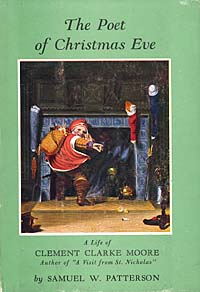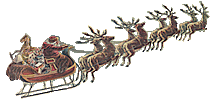 |
|
| Historical Articles | Chronological Articles |
|
Historical Arguments for Henry Livingston, Jr. as the Author of "Night Before Christmas" |
|
|
79 MILE to N. YORK is the writing carved on a milestone that survives from the early years of the nineteenth century, and that stands on the highway connecting the northern and southern parts of the State of New York, by way of the eastern bank of the Hudson River. The numerals and letters are chiseled with an amplitude of line that must have made them, in the post-stage era, easily distinguished by a person journeying past and catching sight of them from the coach window. And even now the "79." heightened by an inlay of white paint, no doubt attracts occasionally the eye of somebody passing in trolley car or automobile. But the inscription is revealed completely only to a traveler afoot, who, pausing to read, inevitably asks himself where the letter has gone that made "Mile" plural; and who may fancy that the wanting "s" was nicked out by the whiffletree of some turnpike teamster swinging wide to make room for another vehicle. To those who like the poems of their childhood well enough to care who wrote them, the seventy-ninth milestone on the Albany Post Road might conceivably be a goal of pilgrimage. For within view of the spot where it is located, lived Henry Livingston Junior, who, according to a tradition handed down through four generations of his descendants and unanimously held by those representing him today, was the author of the famous ballad beginning with the line: 'Twas the night before Christmas, when all through the house. Testimony on the subject of the family tradition includes a letter of one of Livingston's daughters, Eliza Livingston Lansing [1], who, writing in 1879, said she was as sure that her father was the author of "A Visit of St. Nicholas" as that Burns was the author of "Tam O'Shanter," and a letter of a grandson, named Henry Livingston, who wrote in 1900 that his father, Sidney Montgomery Livingston, possessed at one time the original manuscript of the poem, with many corrections. This and a great deal more testimony, both written and oral, bearing witness to Livingston's activity in the early democratic period of American letters, has been gathered by Dr. William S. Thomas of New York City and has been placed in the hands of a member of The Christian Science Monitor staff. Dr. Thomas, as representative of Livingston's descendants, permits the facts he has collected to be published, hoping, he observes, that thereby further information on the authorship of the "St. Nicholas" poem may be drawn from hiding. Only the leading points in the problem will be presented here, yet enough, perhaps, may be touched upon to give readers an agreeable moment of contemplation. The farm on which Henry Livingston, the poet, or, not to be too pretentious about him, the versifier, lived was known as Locust Grove. As seen today from milestone "79." it includes a strip of high, level, tree-dotted land, bordered by a black-green picket fence and cut through by a driveway. Some locusts, ancient, rugged and lofty, border the drieway and make a line for the eye to follow directly to the lawn of the original house. In 1886, Benson J. Lossing, the historian, who lived in Dutchess County, sought proof of Livingston's authorship of the "St. Nicholas" piece, but without success: oral and written testimony of children and grandchildren of the poet of Locust Grove remained the chief reliance of the argument. Today, however, anyone who investigates the subject has material which was unknown in Lossing's time, including documents deposited in the New York Public Library [2]and including also newspapers and magazines, found there and elsewhere, not to mention letters and manuscripts brought out from the garrets and storehouses of Livingston's own descendants. Important amongst this material is a manuscript book of about 45 poems, all of them short and the greater part of them humorous and playful, dating from 1784 to 1789. One-third of them are composed in pairs of anapaestic verses, as is the ballad of "St. Nicholas." Several of the anapaestic pieces bear the descriptive title, "Rebus," and begin with a series of couplets alluding to mytholigical or historic personages, the initials of whose names, taken together, spell the name of some friend of Livingston; and they end with a group of lines, in flattering or bantering vein, describing the social qualities of the friend. There is a rebus on the name of Nancy Crooke, which begins:
Take the name of the swain, a forlorn witless elf, In the second half of this rebus, the usual two-line phrasing is varied with a three-line scheme:
When she swims in the dance, or wherever she goes, An anapaestic piece, entitled "The Acknowledgement," 1787, tells of a young woman building up her headdress in the style of the time
Till gently it rises and swells like a knoll A piece that resembles the "St. Nicholas" ballad not only in metrical design, but also somewhat in pictoral method, is a rhymed letter, of date a year earlier than "The Acknowledgement," which Livingston wrote at Locust Grove and addressed to his brother Beekman, who lived 60 miles northeastward from Poughkeepsie at New Lebanon, on the Massachusetts border, and who kept a shop there. The time when the poet begins the letter is Ten minutes past eight and a very cold night. He mentions one of the women of the family as sitting near him and sewing while he writes, and he goes on with the news: Such gadding, such ambling, such jaunting about-- and he refers to entertainments given by Miss Nancy and others, and says: Next day all the world with the Major must dine. the Major being himself; for he seems at this time to have borne the military title which he earned in the Revolutionary War, though in later years he was more commonly known by the title, which he earned as federal assessor, of Judge. Continuing, he represents all hands as bouncing off to Fishkill, "in a clutter," their purpose being, among other things, to "destroy bread and butter." He portrays his brother Beekman, nicknamed "Baze," as standing, meanwhile, "behind the cold counter"; or as making room for visitors at his shop:
The old tenor merchants push nigher and nigher or, again, as hearing of the arrival of a customer named "Aunt Amy," [3]who has ridden to town with produce to barter: Run! Help the poor creature to light from her jade. In closing, he bids Beekman laugh away sorrow, since it matters but little
Whether here you are rolling in pastime and pleasure Certain of the manuscript poems are found to have been printed in the New York Magazine, or in the Poughkeepsie Journal, at dates two years or so later than they are entered in the book; and when printed they are invariably wihtout signature, except that some of them are signed by the letter "R." whatever that may mean. Unless the family tradition errs, the "St. Nicholas" ballad was written about 19 years after the Beekman epistle, or some time near 1805. But the first date of publication that has been verified is 37 years later, or December 23, 1823, when it appeared anonymously in the Troy [New York] Sentinel. In January, 1829, about a year after Livingston's career closed, the editor of that paper, in discussing the poem, contrived a pun on the word "more" in such a manner as to convey the opinion that a man by the name of Moore was the author. No further editorial attempt to fix the origin of the piece seems to have been made for nearly 10 years. A name for the first time was definitely fixed to it in the public prints late in 1838, when the Troy [New York] Budget, in the course of editorial comment, referred to Clement C. Moore, the Hebrew scholar, of New York, as the person who had written it. In 1844, a book of poems was published by Moore, and the "St. Nicholas" ballad was included in the collection. All but two of the 44 pieces in this book are in iambic meter, and are studiously, elegantly and seriously composed. They are more or less in a moralizing vein, and their style bears some resemblance to that of Whittier. They contain scarcely anything, however, except the ballad, to commend the author as a humorist. The two pieces not iambic are the ballad, and a laborious effort at fun composed in the anapaestic meter of the ballad, entitled "The Pig and the Rooster." This poem of "The Pig and the Rooster" might fairly be compared with the work of the butcher in the Lorraine version of the myth of St. Nicholas, so sadly in it are wit, fancy and imagination dismembered and cast into the tub. The poem of "The Visit," in turn, might be compared with the joyous rectification of the butcher's work by the saint of the Lorraine story. And yet, such comparison cannot be made by way of condoning the inferiority ot "The Pig and the Rooster," for according to the evidence of a note printed on the page with its title, it is the later, instead of the earlier, composition of the two. A professor of American literature, whose opinion was recently asked touching the authorship of "The Visit," said that Moore's long possession put the burden of proof on the Livingston claimants; and he remarked that the author, whoever he was, wrote lightly and from the top of his head. Now Livingston did not always write lightly, yet that was his usual way. As for seeking notice or credit for his writings, that he seems regularly to have omitted to do. On one occasion, he went so far as to write a poem for a Poughkeepsie paper as a holiday supplement, or, in the phrase of the times, as a carrier's address, to which he permitted the name of a newsboy, Seth Parsons, to be signed. He was more careful of his fame as an artist than as a writer, for numerous rather crude illustrations, made from drawings of his, are found in the New York Magazine, signed by his first initial and last name, or by his two initials. |


|

![]() Copyright © 2003, InterMedia Enterprises
Copyright © 2003, InterMedia Enterprises